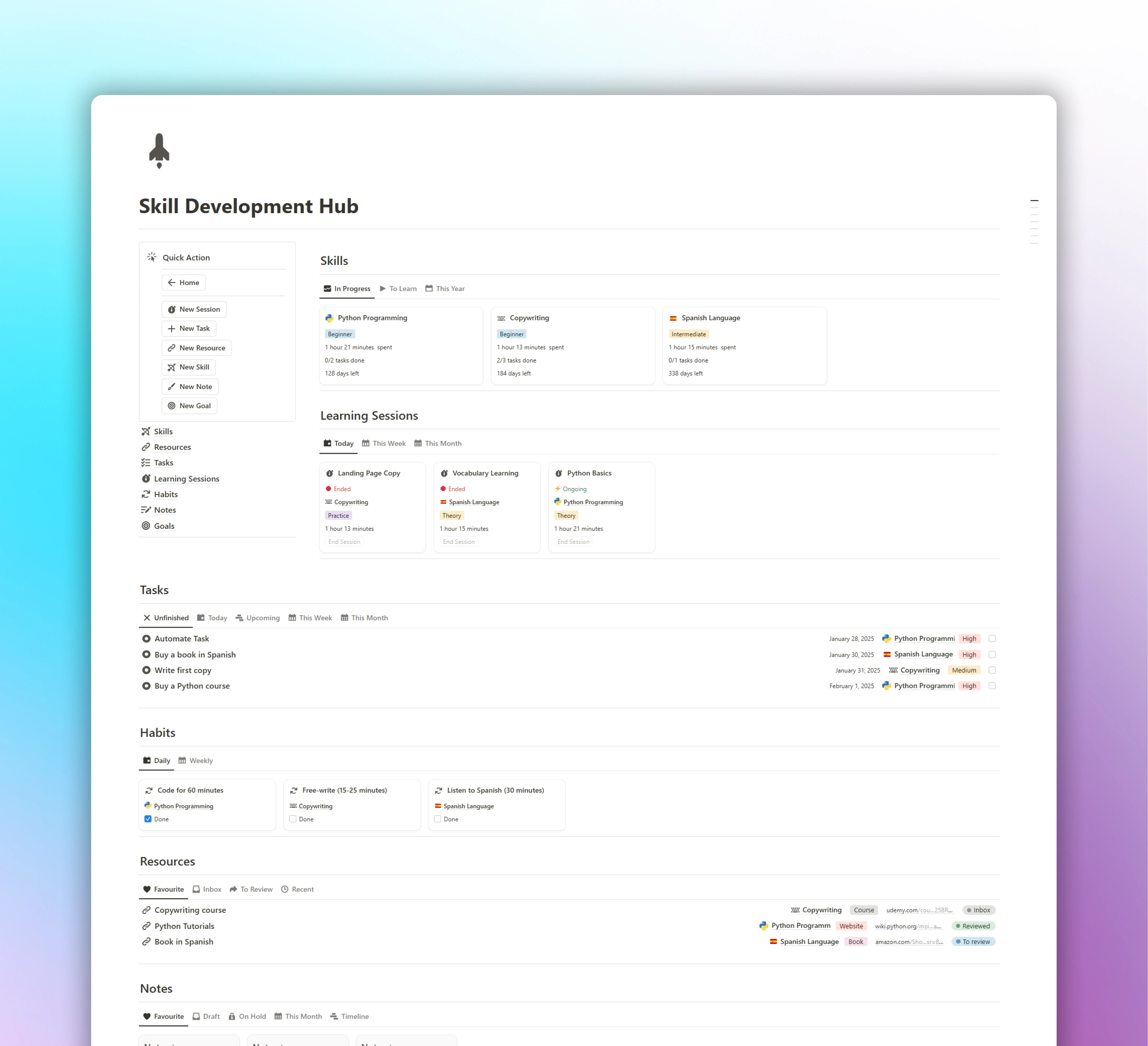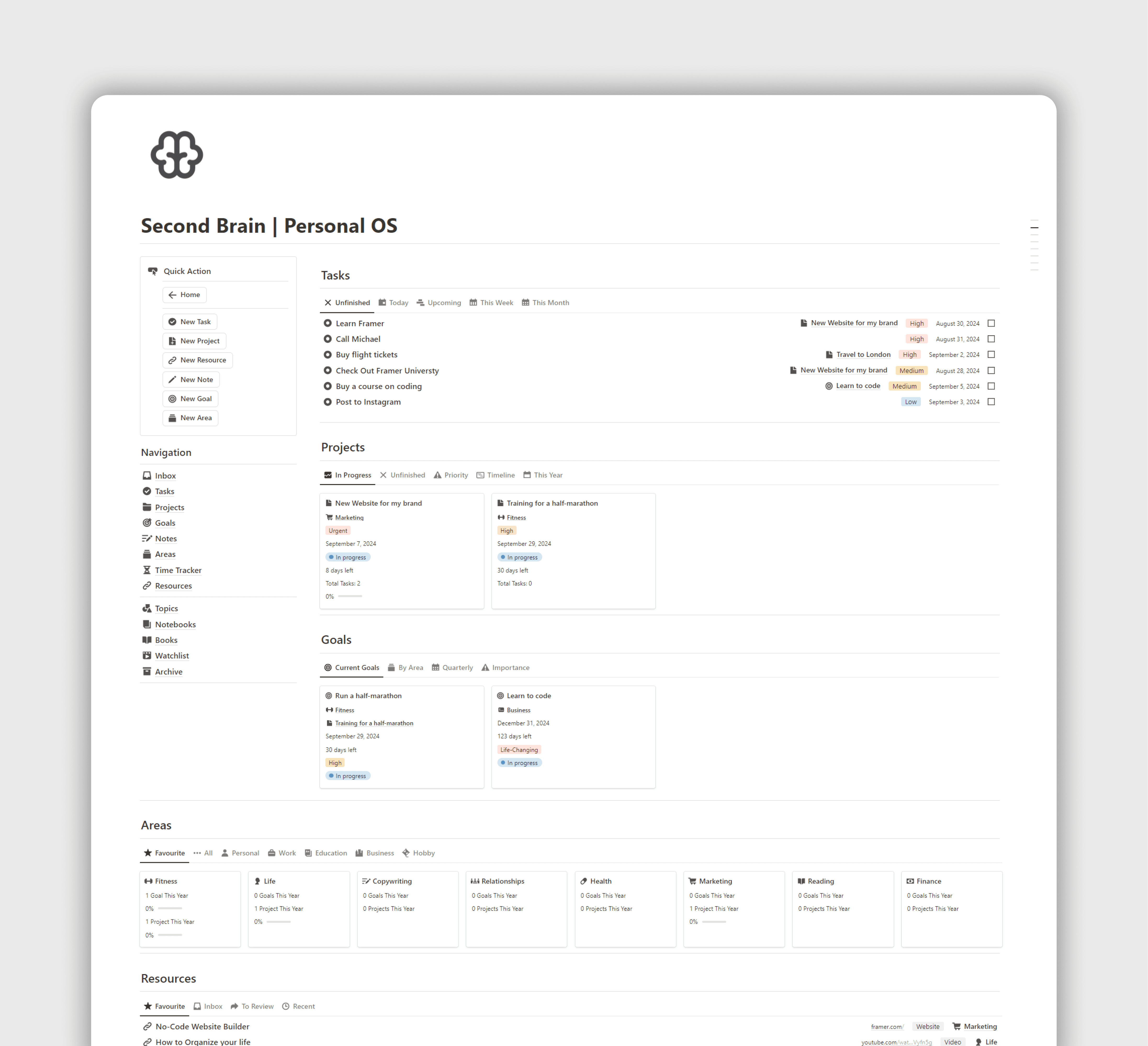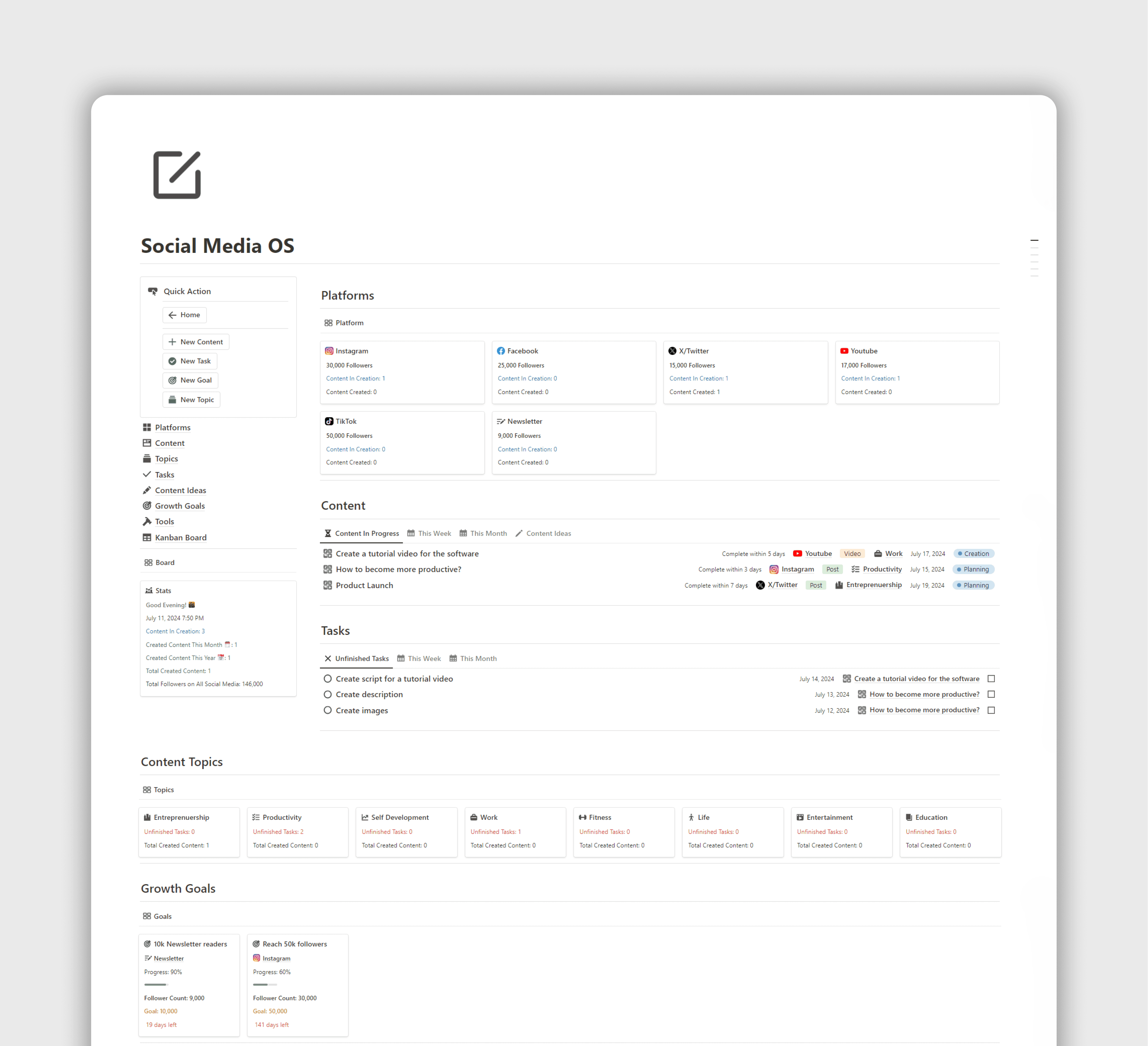How to Build a Second Brain in Notion
Master personal knowledge management with Notion's powerful features.


FocusWhale
Sunday, January 26, 2025
In our digital age, managing information can feel like trying to drink from a fire hose. Enter the concept of a Second Brain - a personal system for organizing and accessing your digital knowledge. This guide will walk you through creating your own Second Brain using Notion, a powerful and flexible workspace tool.
Understanding the Second Brain Concept
What is a Second Brain?
A Second Brain is a personal knowledge management system that helps you capture, organize, and retrieve information efficiently. This concept, popularized by productivity expert Tiago Forte, aims to extend our mental capabilities by creating an external, digital system for storing and processing information.
The core idea is simple: by offloading information storage to a reliable external system, we free up mental space for creativity and problem-solving. A well-organized Second Brain can help you connect ideas, spark creativity, and boost productivity.
Why Use Notion for Your Second Brain?
Notion stands out as an excellent tool for building a Second Brain due to its flexibility and powerful features. Unlike more rigid note-taking apps, Notion allows you to create custom databases, link information in multiple ways, and build complex systems tailored to your needs.
Notion's strength lies in its ability to combine text, databases, and multimedia in a single workspace. This makes it ideal for creating a comprehensive knowledge management system that can grow and adapt with your needs.
Preparing to Build Your Second Brain
Defining Your Goals and Purpose
Before diving into the technical aspects of setting up your Second Brain, it's crucial to clarify your goals. Ask yourself:
What kind of information do you want to store and organize?
How do you plan to use this information in your work or personal life?
What current problems or inefficiencies are you trying to solve?
Having clear answers to these questions will guide your decisions as you build your system.
Assessing Your Current Information Management
Take some time to evaluate how you currently manage information. Do you have notes scattered across multiple apps? Are you struggling to find important documents when you need them? Identifying these pain points will help you design a Second Brain that addresses your specific needs.
The PARA Method: Foundation of Your Second Brain
Overview of the PARA Method
The PARA method, developed by Tiago Forte, provides a simple but powerful framework for organizing information. PARA stands for:
Projects: Short-term efforts in your work or life
Areas: Long-term responsibilities you want to manage
Resources: Topics or themes of ongoing interest
Archives: Inactive items from the other three categories
This method helps you organize information based on its actionability and relevance to your current goals.
Adapting PARA for Notion
Implementing PARA in Notion involves creating main pages for each category and designing database structures to manage the information within them. Here's a basic structure you might use:
Create a top-level page for each PARA category
Within each category, create databases to store relevant information
Use Notion's relational database features to link items across categories
This structure provides a flexible foundation that you can customize to fit your specific needs.
Step-by-Step Guide to Building Your Second Brain in Notion
Setting Up Your Notion Workspace
Start by creating a new workspace in Notion or a dedicated section within an existing workspace. This will be the home for your Second Brain.
Next, set up your basic preferences. Consider enabling features like dark mode or adjusting your default page settings to streamline your workflow.
Designing Your Main Dashboard
Your dashboard will serve as the central hub of your Second Brain. Create an overview page that includes:
Quick links to your main PARA categories
Widgets or embedded views of your most important databases
A space for daily notes or quick capture

Implementing the Projects Section
In the Projects section, create a database to track all your active projects. Consider including the following properties:
Project name
Status (Active, On Hold, Completed)
Deadline
Related Area
Key tasks or milestones
You might also want to create a template for new project pages, ensuring consistency in how you structure project information.
Structuring the Areas Section
Areas represent the ongoing responsibilities and roles in your life. Create pages for each major area, such as:
Work
Health and Fitness
Personal Development
Finances
Within each area, you can create linked databases for related projects, resources, and notes.
Organizing the Resources Section
The Resources section is where you'll store reference materials and information on topics of interest. Create a master database for all your resources, with properties like:
Title
Type (Article, Book, Video, etc.)
Tags or Categories
Date Added
Source URL
Use Notion's filtering and views to create different ways of accessing your resources based on your needs.
Establishing the Archives
The Archives section is for items that are no longer active but you want to keep for future reference. Create an archive database or folder structure that mirrors your active PARA categories.
Develop a consistent process for moving items to the archive, ensuring that your active sections remain uncluttered and focused on current priorities.
Setting Up Cross-Linking and Relationships
One of Notion's most powerful features is its ability to create relationships between different pieces of information. Use this to your advantage by:
Creating bi-directional links between related items
Using relational databases to connect projects, areas, and resources
Implementing a consistent tagging system across your Second Brain
These connections will help you discover new insights and relationships within your knowledge base.
Advanced Techniques for Notion Second Brain
Implementing Capture Systems
A key aspect of maintaining your Second Brain is having efficient ways to capture new information. Consider setting up:
A quick capture inbox for fleeting thoughts and ideas
The Notion Web Clipper for saving online content directly to your workspace
Mobile shortcuts for adding notes on the go
Develop a routine for processing your inbox regularly, ensuring that new information is properly categorized and integrated into your system.
Knowledge Synthesis Techniques
As your Second Brain grows, you'll want to develop techniques for synthesizing and refining your knowledge. Two powerful methods are:
Progressive Summarization: Highlight and distill the key points of your notes over time, creating layers of increasingly refined information.
Evergreen Notes: Create and maintain a collection of notes that represent your most important and well-developed ideas, continuously refining them as your understanding grows.
Automating Your Second Brain
Leverage Notion's advanced features and integrations to automate parts of your Second Brain:
Use Notion formulas to automatically categorize or tag items based on certain criteria
Set up integrations with tools like Zapier or IFTTT to automatically add information from other apps to your Notion workspace
Create templates and duplicate them to quickly set up new projects or notes with predefined structures
Automation can significantly reduce the time and effort required to maintain your Second Brain, allowing you to focus on using and developing your knowledge.
Maintaining and Evolving Your Second Brain
Regular Review and Cleanup Processes
To keep your Second Brain useful and relevant, establish regular review routines:
Weekly Review: Go through your projects and tasks, update statuses, and ensure everything is properly categorized.
Monthly Review: Look at your Areas and Resources, archive completed or inactive items, and identify any new areas of focus.
Quarterly or Annual Review: Evaluate the overall structure of your Second Brain, make major updates or reorganizations, and set new goals for how you want to use and develop your system.
Continuous Improvement Strategies
Your Second Brain should evolve as your needs and knowledge grow. Stay open to refining your system:
Regularly evaluate which parts of your system you use most and least, adjusting accordingly
Experiment with new Notion features or community-created templates to enhance your setup
Seek inspiration from other Notion users and knowledge management experts, adapting their ideas to fit your needs
Remember, the goal is to create a system that works for you, not to achieve some idealized perfect setup.

Conclusion
Building a Second Brain in Notion is a powerful way to manage your digital information and boost your productivity. By following the PARA method and leveraging Notion's flexible features, you can create a personalized knowledge management system that grows with you.
Remember that building and maintaining a Second Brain is an ongoing process. Start simple, be consistent in using your system, and don't be afraid to make adjustments as you learn what works best for you. With time and practice, your Second Brain will become an invaluable tool for capturing, organizing, and utilizing your knowledge.
Whether you're a student, professional, or lifelong learner, a well-structured Second Brain can help you make better use of the information you encounter and generate new insights from your accumulated knowledge. So dive in, start building, and discover the benefits of having a powerful, personalized knowledge management system at your fingertips.
PARA method, knowledge management, productivity, digital organization, Notion workspace
Other Blog Posts
FAQ
Premium Notion Systems
Subscribe to Our Newsletter
Join the 7,000 subscribers who read our irregular newsletter.











